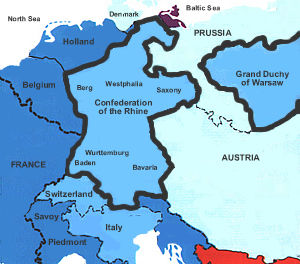 |
 |
 |
Confederation of the Rhine1806-1813
The more than 15 million people living within the Confederation provided both a physical barrier against enemies on France's eastern borders and also sent large contingents of troops to join its armies. The members of the Confederation included large kingdoms and duchies, together with smaller principalities and city states. The key ones were Bavaria (3.5 million subjects), Saxony (2 million), Westphalia (2 million), Wurttemburg (1.5 million) Baden (1 million) and the Duchy of Warsaw (4 million). The others were Cleve-Berg, Hesse-Darmstadt, Anhalt-Bernburg, Anhalt-Dessau, Anhalt-Kothen, Hohenzollern-Hechingen, Hohernzoller-Sigmaringen, Isenburg, Leyen, Leichtenstein, Mecklinburg-Schwerin, Mecklenburg-Strelitz, Ebersdorf, Gera, Gtreiz, Lobenstein, Schleiz, Saxe-Coburg-Saalfield, Saxe-Gotha-Altenburg, Saxe-Hildburghausen, Saxe-Meningen, Saxe-Weimar, Schaumburg-Lippe, Schwarburg-Rudolstadt, Schwarzburg-Sonderhausen, Waldeck, Wurzburg, Erfurt and Frankfurt. Disaffection within the group over continued support for France began after Bonaparte's invasion of Russia and the Allied victory at Leipzig saw many of the confederation switch sides to help the Allies during the 1813 War of German Liberation. |
||
|
Napoleon
Bonaparte
|
|
| Career | Portraits |
| Quotes | Family |
| Loves | Letters |
| Plots | Murdered? |
| His will | Places |
|
Era
of Napoleon
|
|
| Powers | Opponents |
| Coalitions | Allies |
| People | Timelines |
| Key sites | Shrapnel |
|
Warfare
|
|
| Campaigns | Battles |
| Armies | Generals |
| Marshals | Winners |
| Glossary | Medical |
| Weapons | 1812 War |
| Uniforms | Battlefields |
|
War
at Sea
|
|
| Naval War | Heroes |
| Artworks | Signals |
| Nelson | Trafalgar |
|
Maps
|
|
| Key Maps | Peninsula |
| Animated | 1796/1800 |
| 1809 | Russia |
|
French
Revolution
|
|
| Revolution | Guillotine |
| Posters | People |
|
Art,
Film, Games
|
|
| Education | Goya |
| Sharpe | Hornblower |
| Books | Movies |
| DVDs | Music |
| Wargames | Images |
| Cartoons | Caricatures |
|
Other
|
|
| About Us | Sources |
| Awards | Sitemap |
| Links | Militaria |
| Miniatures | Reenactors |
| Forum | Quizzes |
| Home | Waterloo Diorama |
 The
Confederation of the Rhine was formed in 1806 when 16 German minor
states decided to throw their nations' futures in with
The
Confederation of the Rhine was formed in 1806 when 16 German minor
states decided to throw their nations' futures in with